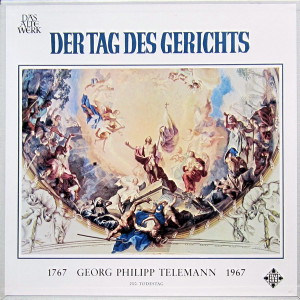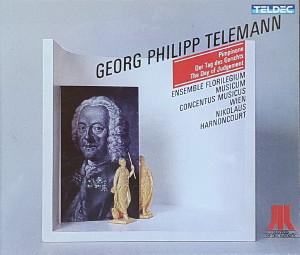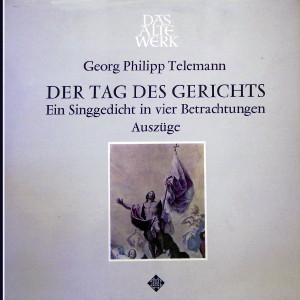 |
2 LP -
SAWT 9484/85-A - (p) 1966
|

|
| 3 CD -
8.35774 XD - (c) 1989 |
 |
| 1 LP -
SAWT 9519-B - (c) 1968 |
|
Georg Philipp
Telemann (1681-1767)
|
|
|
|
|
|
|
|
|
|
| Der Tag des Gerichts
- Ein Singgedicht in vier Betrachtungen
von Christian Wilhelm Alers |
|
|
|
|
|
|
|
|
|
| Die erste Betrachtung |
|
|
32' 16" |
|
| - Einleitung |
* |
3' 54"
|
|
A1 |
| - Chor: "Der Herr kommt mit
vieltausend Heiligen" |
* |
1' 34"
|
|
A2 |
| - Rezitativ (Baß): "Ruft
immerhin, des Pöbels Wut zu zähmen" |
* |
0' 51"
|
|
A3 |
| - Arie (Baß): "Fürchetet
nur, fürchtet des Donnerers Schelten" |
|
7' 49" |
|
A4 |
| - Rezitativ (Baß, Sopran,
Tenor): "Wer ist, der kühn sein Joch
Zerreißt?" |
|
1' 42" |
|
A5 |
| - Arie (Tenor): "Jetz weiß
ich's überkluge Köpfe" |
* |
4' 47"
|
|
A6 |
| - Rezitativ (Alt): "Genug
der Schande Bloßgestellt" |
|
1' 08" |
|
A7 |
| - Arie (Alt): "Des Sturmes
Donnerstimmen schallen" |
* |
6' 34"
|
|
B1 |
| - Rezitativ (Sopran): "Ganz
recht, das Endliche vergeht" |
|
1' 29" |
|
B2 |
| - Chor: "Dann jauchzet der
Gerechten Same" |
* |
2' 28"
|
|
B3 |
| Die zweite Betrachtung |
|
|
15' 32" |
|
| - Chor: "Es rauscht" |
* |
5' 15"
|
|
B4 |
| - Accomp. Rezitativ (Baß):
"Da sind sie, der Verwüstung Zeichen!" |
* |
2' 31"
|
|
B5 |
| - Arie (Baß): "Da kreuzen
verzehrende Blitze" |
* |
4' 44"
|
|
B6 |
| - Rezitativ (Tenor):
"Gewaltig Element!" |
|
1' 00" |
|
C1 |
| - Arioso (Knaben-Sopran):
"Ich aber schwinge mich empor" |
* |
2' 02"
|
|
C2 |
| Die dritte Betrachtung |
|
|
14' 46" |
|
| - Accomp. Rezitativ (Alt):
"Ich sehe, Gott, den Engel deiner Rache!" |
|
1' 46" |
|
C3 |
| - Arioso (Tenor): "So
spircht der Herr, der mich gesandt" |
|
1' 41" |
|
C4 |
| - Rezitativ (Alt): "Nun
dränget sich der Kreis der ganzen Erde" |
* |
1' 33"
|
|
C5 |
| - Arie (Baß): "Seid mir
gesegnet, ihr Gerechten" |
* |
2' 31"
|
|
C6 |
| - Choral: "Du, Ehren König,
Jesu Christ" |
* |
1' 21"
|
|
C7 |
| - Rezitativ (Tenor): "Da
sitzet Er - o wie nenn' ich ihn?" |
* |
1' 05"
|
|
C8 |
| - Chor: "Ach Hilfe! Weh uns!
Hilfe! Rat!" |
* |
1' 35"
|
|
C9 |
| - Rezitativ (Tenor): "Wir
flehn umsonst. - Der Tod entweicht!" |
* |
0' 30"
|
|
C10 |
| - Arie (Baß): "Hinweg von
meinem Angesichte!" |
* |
2' 44"
|
|
C11 |
Die vierte Betrachtung
|
|
|
20' 15" |
|
| - Chor: "Schallt, ihr hohen
Jubellieder!" |
* |
2' 46"
|
|
D1 |
| - Arioso (Baß): "Nuni st das
Heil und die Kraft" |
* |
1' 04"
|
|
D2 |
| - arioso (Tenor): "Ein
ew'ger Palm umschlingt mein Haar" |
|
3' 21" |
|
D3 |
| - Chor: "Heilig ist unser
Gott!" |
|
0' 24" |
|
D4 |
| - Arioso (Knaben-Alt):
"Heil! Wenn um des Erwürgten willen" |
* |
3' 27"
|
|
D5 |
| - Arioso (Baß, Chor): "Das
Lamm, das erwürget ist" |
* |
1' 40"
|
|
D6 |
| - Arie (Knaben-Sopran): "Ich
bin erwacht nach Gottes Bilde" |
* |
2' 39"
|
|
D7 |
| - Chor: "Lobt ihn, ihr
Seraphinen-Chöre!" |
|
2' 23" |
|
D8 |
| - Rezitativ (Knaben-Alt):
"Es ist geschehen! Die Tugend ist
gerächt!" |
|
0' 47" |
|
D9 |
| - Chor: "Die Rechte des
Herrn ist erhöhet!" |
* |
1' 44"
|
|
D10 |
|
|
|
|
|
| Cora
Canne-Meijer, Alt |
Max
van Egmond, Baß
|
|
Kurt
Equiluz, Tenor
|
Gertraud
Landwehr-Herrmann, Sopran |
|
|
|
Vier Solisten der Wiener
Sängerknaben, Sopran und
Alt / Ferdinand Grossmann, Einstudierung
|
|
| Monteverdi-Chor
Hamburg / Jürgen Jurgens, Leitung |
|
|
|
CONCENTUS MUSICUS Wien (mit
Originalinstrumenten)
|
|
| -
Alice Harnoncourt, Violine |
-
Karl Gruber, Oboe, Oboe d'amore |
|
| -
Peter Schoberwalter, Violine |
-
Otto Fleischmann, Fagotto |
|
| -
Kurt Theiner, Violine |
-
Josef Spindler, Clarine |
|
| -
Walter Pfeiffer, Violine |
-
Richard Rudolf, Clarine |
|
-
Josef de Sordi, Violine
|
-
Kurt Hammer, Pauken |
|
| -
Nikolaus Harnoncourt, Tenorviola |
-
Hermann Rohrer, Naturhorn |
|
| -
Hermann Höbarth, Violoncello |
-
Hans Fischer, Naturhorn |
|
| -
Eduard Hruza, Violone |
-
Ernst Mühlbacher, Naturhorn |
|
| -
Jürg Schaeftlein, Oboe |
-
Herbert Tachezi, Cembalo |
|
| -
Bernhard Klebel, Oboe |
|
|
|
|
| Nikolaus
Harnoncourt, Gesamtleitung |
|
|
Luogo e data
di registrazione
|
| Bayerischen Hof, Vienna
(Austria) - 21-27 marzo 1966 |
|
Registrazione
live / studio
|
| studio |
Producer / Engineer
|
| - |
Prima Edizione
CD
|
Teldec "Masters of the
Baroque" - 8.35774 XD - (3 cd) - 70' 31"
+ 62' 53" + 53' 14" - (c) 1989 - AAD
|
Prima
Edizione LP
|
Telefunken "Das Alte Werk" -
SAWT 9484/85-A - (2 lp) - 44' 15" + 37'
13" - (p) 1966
Telefunken "Das Alte Werk" -
SAWT 9519-B - (1 lp) - 61' 01" - (p)
1968 - Auszüge *
|
Note
|
| Questa prima riedizione in Cd
contiene altre opere di Telemann non
interpretate da Nikolaus Harnoncourt:
"Pimpinone oder Die Ungleiche Heyrath"
ed i "Pariser Quartette" 1 & 6. |
|
|
On the
Performance of the Work
with Original Instruments
|
One
of the most interesting
facets of Telemann's
manifold artistic
personality is his
incredible adaptability. He
understood like hardly any
other how to penetrate the
stylistic peculiarities of
other composers or foreign
nations. His instrumental
works in French or Italian
style are genuine French and
Italian music such as, for
instance, M. Marais or
Vivaldi wrote. But his
adaptability and the
flexibility of his creative
power are displayed most
clearly in the vigour with
which, in all the phases of
his long life as a composer,
he wrote the most modern,
frequently even
"avant-garde" music. This is
by no means the rule; most
artists remain faithful to
the style they have attained
when their creative powers
were at their zenith, with
slight deviations, to the
end of their lives. We thus
find them, in their old age,
cultivating a
conservative style and
leaving the search for the
new to a younger generation.
Telemann, however, did not
only take note of the mighty
revolutions taking place in
the thirties of the 18th
century, with the rise of
the Mannheim and Viennese
styles, with the greatest
interest; he still
participated himself as an
old man in the development
of the new musical language.
One of the most amazing
works in this connection is
“The Day of Judgement”. Here
there is hardly anything
more to be found of the
traditional, late baroque
Telemann style; instead, all
the harmonic, melodic
(typical phrases and
flourishes) and dynamic
elements of the new style
are applied with supreme
mastery. Forte and piano are
meticulously indicated,
there are "Mannheim
crescendos” etc. etc. It
should be remembered that
this oratorio was written 35
years before Haydn’s
"Creation"! One is almost
tempted to believe that
Telemann wanted to "show the
youngsters a thing or two” -
namely that he still had an
important word to say, even
in the most progressive
musical language.
The instrumentation had
always been an essential
part of the composition to
Telemann; here again he was
far ahead of most composers
of his generation, in whose
works many instruments could
be changed round at will. He
already committed himself in
his younger years, for the
sake of instrumental
technique and above all
accurate characterization,
to a mode of writing that
was to exploit the
peculiarities of sound and
of technique of each
instrument to the full:
"...I made the acquaintance
of the diverse natures of
various instruments, on
which I did not omit to
excel myself with the
greatest possible assiduity.
How necessary and useful it
is to be able to distinguish
these features in their
characteristic pieces, I
still experience to this
very day, and say that
nobody, without knowing
this, can be merry and happy
in his invention. The exact
acquaintance with the
instruments is also
indispensable in
composition. For otherwise
one must pass the verdict:
The violin is
treated in organ fashion
The
flute and hautboy felt
like trumpets
The gamba
saunters along, just as
the bass goes
Only that
here and there 2. trill
stands as well.
No, no, it is
not enough that only the
notes sound
That
you know how to put the
rules to good use.
Give every
instrument what it can
tolerate
Thus the
player has delight, you
have pleasure from it.
In a work so ingenious in
its instrumentation as "The
Day of Judgement",
performance with original
instruments acquires a
special significance. For if
we replace these by their
namesakes in general use
today, a totally distorted
sound-picture results, which
does not correspond to the
composer’s intentions in any
respect. This is
particularly noticeable in
the case of the trumpets and
timpani, for instance. The
natural trumpets of the 18th
century were double the
length of modern valve
trumpets of the same pitch,
their fundamental note was
thus an octave lower. Since
the bore of both instruments
is the same, the mensuration
- the proportion of the bore
to the length of the column
of air - differs by double.
The modern valve trumpet is
therefore, strictly
speaking, not a trumpet at
all according to its
mensuration, but a little
valve trombone. Thus on the
natural trumpet everything
must be played one octave
higher in relation to its
fundamental note. In other
words, what is played in the
third octave on the modern
trumpet (it is not played
any higher) is played in the
fourth octave on the natural
trumpet. The much longer
column of air, however,
results in a considerably
gentler, softer tone the
higher the instrument is
played. The usual trumpet
dynamics, the higher - the
louder, is thus the exact
reverse of what results from
using the natural trumpet,
not to speak of the entirely
different tone colour caused
by the different
mensuration.
The timpani of that time had
a considerably shallower
shell than those of today,
and were played with quite
light wooden sticks. We do
not therefore get the
voluminous, full sound of
the modern instrument played
with felt-headed sticks, but
a very slender and
transparent sound that
combines ideally with the
bright, light notes of the
natural trumpet and the
other instruments of the
baroque orchestra.
The same applies to all
other instruments too,
particularly to the natural
horns which, after all,
demand a similar technique
of playing to the natural
trumpet.
The old instruments react
quite differently to the
modern ones in mixtures and
doublings. Whereas with the
latter each wind instrument
added, say, to the violins
clearly retains its own
peculiarities of sound, the
various sounds of the old
instruments blend completely
into new colours. Violins
alone, violins and oboe,
both these and trumpet, all
these and horn - these are
roughly the essential tone
colours used in the tutti
passages of this work. This
phenomenon of blending into
new sounds is the reason why
the composers of the 18th
century so often let
different kinds of
instruments play in unison.
The typical individual
colour of each instrument
then repeatedly makes its
appearance in between in
solo passages.
Since the right blend of the
sounds is therefore so
important, the number of
musicians, the numerical
relation of the instruments
to one another acquires the
greatest significance. One
is amazed again and again
how even the smallest
groups, constituted in the
right proportions, can
produce magnificent sound
effects. At that time they
did not yet feel it
necessary to express the
monumental character of a
musical work with the aid of
sound-producing masses; the
musical substance itself was
enough. Even in his most
sumptuous performances in
Hamburg, Telemann never had
more than about eight
strings and the necessary
wind. This is quite evident
from many bills that have
been preserved. The number
of musicians that Telemann
had, and was also used in
this recording, corresponds
exactly to that stated by
Quantz in his "Versuch einer
Anweisung, die Flute
Traversière zu spielen”
(1752): "To six violins
(here there are five) one
uses: one viola, one
violoncello and one
contraviolon of medium size
and a bassoon." It is also
very interesting that
Telemann in Hamburg, in
contrast to Bach in Leipzig,
could also employ female
singers for sacred music,
and thus did not only
perform with boy choristers.
Nikolaus
Harnoncourt
|
|
Nikolaus
Harnoncourt (1929-2016)
|

|

|
|